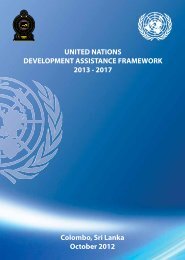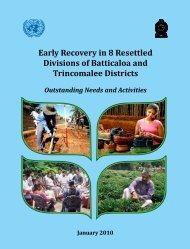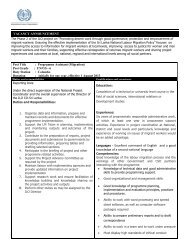Sri Lanka Human Development Report 2012.pdf
Sri Lanka Human Development Report 2012.pdf
Sri Lanka Human Development Report 2012.pdf
Create successful ePaper yourself
Turn your PDF publications into a flip-book with our unique Google optimized e-Paper software.
Education Commission. Private and non-governmental<br />
training institutions play a key role—by the end of 2010,<br />
1,138 were registered as providers. The Commission<br />
formulates policy, plans and coordinates, sets standards, and<br />
regulates the sector for the relevance and quality of training.<br />
Most organizations charge fees, but national and<br />
international charities also support a large network of free<br />
institutions. The Commission has put in place a system for<br />
registering training outlets and accrediting courses as part<br />
of a credible quality assurance system. 144<br />
Table 4.1: Trends in Education Provision<br />
2000 2005 2010<br />
General education<br />
Total number of schools 10,615 10,461 10,502<br />
Government schools 9,976 9,723 9,685<br />
Pirivena schools 561 653 719<br />
Private schools* 78 85 98<br />
Government schools<br />
Number of teachers 186,097 189,234 212,457<br />
Number of students 4,193,908 3,942,077 3,940,072<br />
Higher education<br />
Number of universities 13 15 15<br />
Number of other higher - 16 17<br />
educational institutions<br />
Number of new admissions 11,805 14,520 21,547<br />
Number of lecturers 3,241 3,875 4,984<br />
Technical education and vocational training<br />
Number of registered institutions<br />
Government and semi-government 556 (2001) n.a. 939<br />
Private 252 (2001) n.a. 898<br />
Non-governmental 112 (2001) n.a. 240<br />
Intake 67,612 (2002) 63,040 (2006) 108,125<br />
Public expenditure on education (Rs. millions)** 30,929 63,557 104,248<br />
Current 23,794 50,697 85,195<br />
Capital 7,135 12,860 19,053<br />
Notes: * Some private schools, popularly called ‘international schools’, provide education services, but are registered<br />
as companies; as such, these are not included in this table.<br />
** Denotes government expenditure on general and higher education. N.a. means not available.<br />
Sources: Central Bank of <strong>Sri</strong> <strong>Lanka</strong> 2010, Tan and Chandrasiri 2004, Tertiary and Vocational Education Commission<br />
2010b, and Ministry of Youth Affairs and Skills <strong>Development</strong> 2012.<br />
Chapter 4 Bridging <strong>Human</strong> <strong>Development</strong> Gaps: EDUCATION 61






